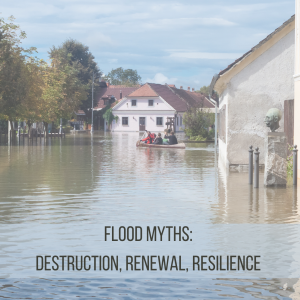
Wednesday Feb 12, 2025
Flood Myths: Tales of Destruction, Renewal, and Resilience
Welcome back to None But Curious! Can you believe it’s 2025? We’re kicking off Season 3 with an episode that dives deep—literally—into the flood myths that have shaped human storytelling across cultures and time. From ancient Mesopotamia to China, from the Bible to Hindu mythology, flood narratives have long been a powerful way for humanity to explore destruction, renewal, and resilience.
Why Do So Many Cultures Have Flood Myths?
Flood myths are a recurring theme in global storytelling. Whether in the Epic of Gilgamesh, the story of Noah’s Ark, the tale of Manu in Hindu tradition, or China’s Gun-Yu myth, these stories share striking similarities. Water has always been a force of nature that both nurtures life and wipes the slate clean, offering the possibility of renewal.
These myths often share a structure:
-
A civilization or people face divine judgment or natural catastrophe.
-
A chosen individual is warned and builds an ark, ship, or refuge.
-
The flood destroys the old world.
-
The survivor(s) begin anew, often with a divine covenant or blessing.
It’s fascinating to see how different cultures interpreted these stories and what they reveal about human nature.
Comparing the Myths
The Epic of Gilgamesh (Ancient Mesopotamia)
One of the earliest flood myths appears in the Epic of Gilgamesh. The god Enlil, irritated by humanity’s noise, decides to wipe them out with a great flood. However, the wise god Ea warns a righteous man, Utnapishtim, instructing him to build a massive ship. He gathers his family, animals, and seeds of all plants. The storm rages for seven days and nights, and when it ends, Utnapishtim sends out birds to find dry land. The gods, impressed by his devotion, grant him immortality.
Noah’s Ark (The Bible)
A well-known parallel is found in Genesis. God, seeing the corruption of humanity, instructs Noah to build an ark and take pairs of animals to survive a coming flood. For 40 days and 40 nights, the rains pour, wiping out life except for those aboard the ark. After the flood, Noah releases a dove, which returns with an olive branch, signaling land. God then makes a covenant with Noah, marking the sky with a rainbow as a promise never to flood the earth again.
Manu and the Fish (Hindu Mythology)
In Hindu tradition, the flood myth revolves around Manu, a wise man who is warned by the god Vishnu, appearing as a small fish. Vishnu tells Manu to build a boat and gather seeds and animals. As the floodwaters rise, the fish grows larger, guiding Manu’s boat to safety in the Himalayas. After the flood, Manu repopulates the world with the creatures and seeds he saved.
The Great Flood of China (Gun-Yu Myth)
In Chinese mythology, a great flood threatened civilization for generations. The emperor called upon Gun, who attempted to control the waters with magical soil but ultimately failed. His son, Yu, took a different approach. Instead of blocking the waters, he worked with them, carving out canals and irrigation systems to redirect the flood. His efforts were successful, and Yu became a legendary ruler, symbolizing resilience and adaptation.
Could These Myths Be Based on Real Events?
Some scientists believe these myths might have been inspired by actual floods. The Black Sea Deluge Hypothesis suggests a massive flood occurred around 7,500 years ago, submerging settlements along the Black Sea. Similarly, an ancient flood in China around 1920 BCE might have inspired the Gun-Yu myth.
Floods are common natural disasters, and ancient societies may have preserved their experiences through storytelling, blending history with mythology.
Cultural Exchange and the Evolution of Myths
Ancient travelers and traders didn’t just exchange goods—they also shared stories. The similarities between flood myths suggest that as people moved, they carried these tales with them, adapting them to their own cultures. It’s like history’s oldest game of telephone, where the core story remains, but details shift.
Flood Myths as Symbols of Renewal
Flood myths are about more than destruction—they are about hope and second chances. They remind us that even after catastrophe, there is an opportunity to rebuild. They teach resilience, morality, and the importance of working in harmony with nature.
Final Thoughts
So, why do flood myths continue to captivate us? Perhaps because they tap into a universal human experience—the fear of loss, the struggle for survival, and the hope for renewal. In a world still shaped by natural disasters, these ancient stories continue to hold meaning, reminding us that even after the storm, there’s a chance to begin again.
If you enjoyed this episode, don’t forget to like, comment, and subscribe to None But Curious for more explorations of mythology, history, and the awe in the ordinary!
No comments yet. Be the first to say something!